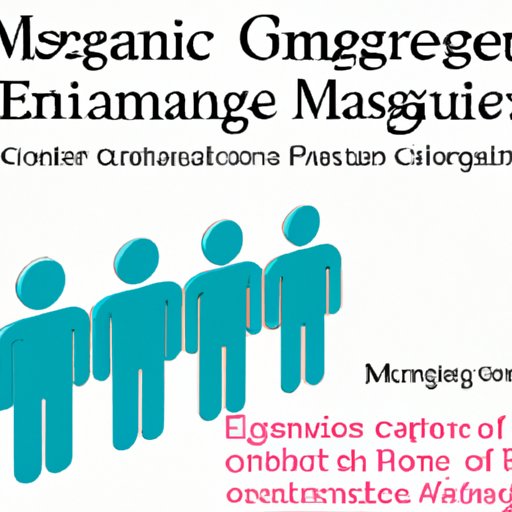Introduction
Organizational culture is the set of values, beliefs, behaviors, customs, and attitudes that characterize a particular organization. It is the shared understanding among members of an organization about what is important, how people should behave, and what goals the organization should pursue. In short, it is the personality of an organization.
Organizational culture has become increasingly important in today’s business world as it can have a significant impact on employee engagement, customer satisfaction, and overall organizational performance. It is essential for organizations to understand the importance of organizational culture and how to develop an effective one that will lead to positive outcomes.

Exploring the Different Types of Organizational Cultures
Organizational cultures can vary greatly depending on the type of organization. Common types of organizational cultures include autocratic, democratic, bureaucratic, and collaborative.
Autocratic: Autocratic cultures are characterized by centralized decision-making power and top-down communication. Employees are expected to follow the decisions of their leaders without question. This type of culture is often found in military or government organizations.
Democratic: Democratic cultures emphasize open communication and collaboration between employees and leaders. Decisions are made through dialogue and consensus-building. This type of culture is often found in startups and small businesses.
Bureaucratic: Bureaucratic cultures are characterized by strict rules, regulations, and procedures. Decisions are made through a hierarchical chain of command. This type of culture is often found in large corporations and government agencies.
Collaborative: Collaborative cultures emphasize teamwork and cooperation. Decision-making power is distributed among multiple stakeholders. This type of culture is often found in research-based organizations and universities.

The Impact of Organizational Culture on Employee Engagement
Organizational culture can have a profound effect on employee engagement. According to a study by the Society for Human Resource Management, “employees who report higher levels of culture satisfaction are more likely to be engaged and committed to their work.”
An effective organizational culture can lead to increased motivation, improved job satisfaction, and higher productivity. Employees who feel valued and supported are more likely to be engaged in their work and have a greater sense of loyalty to their organization.
How to Develop an Effective Organizational Culture
Developing an effective organizational culture requires careful planning and consideration. Organizations should start by establishing core values that define the company’s mission and vision. These values should be communicated clearly throughout the organization and reinforced through daily practices.
Organizations should also communicate expectations to employees in order to ensure that everyone is on the same page. This includes setting clear goals, providing feedback, and encouraging open communication. Finally, organizations should create a supportive environment in which employees are respected and valued.
The Benefits of Establishing a Positive Organizational Culture
Establishing a positive organizational culture can lead to numerous benefits for both employees and the organization. These benefits include increased employee retention, improved customer service, and enhanced organizational performance.
Employees who feel valued and supported by their organization are more likely to stay with the company for longer periods of time. They are also more likely to be motivated and productive in their roles. Additionally, customers are more likely to have a positive experience with an organization that has a strong culture of respect and support.

Strategies for Maintaining an Organizational Culture
Once an organization has established a positive culture, there are several strategies for maintaining it. Organizations should establish clear policies and procedures that align with their core values and communicate these expectations to employees.
Organizations should also provide regular feedback to employees in order to ensure that they are meeting expectations. Finally, organizations should encourage open communication between employees and leaders to ensure that everyone is on the same page.
Case Studies of Successful Organizational Cultures
There are many examples of organizations that have successfully implemented effective organizational cultures. Here are three examples:
Example 1: Google: Google is known for its innovative and collaborative culture. The company emphasizes openness, creativity, and experimentation. Employees are encouraged to take risks and think outside the box.
Example 2: Zappos: Zappos is well-known for its customer-focused culture. The company emphasizes respect, integrity, and passion. Employees are encouraged to put the customer first and go above and beyond to provide excellent service.
Example 3: Southwest Airlines: Southwest Airlines is renowned for its fun and friendly culture. The company emphasizes team spirit and collaboration. Employees are encouraged to be creative and find ways to make customers happy.
Conclusion
Organizational culture is a powerful tool for driving employee engagement, customer satisfaction, and overall organizational performance. It is essential for organizations to understand the importance of organizational culture and how to develop an effective one. Organizations should start by establishing core values, communicating expectations, and creating a supportive environment. Once an organization has established a positive culture, there are several strategies for maintaining it, such as establishing clear policies and procedures, providing feedback, and encouraging open communication. There are many successful examples of organizations that have implemented effective organizational cultures.
(Note: Is this article not meeting your expectations? Do you have knowledge or insights to share? Unlock new opportunities and expand your reach by joining our authors team. Click Registration to join us and share your expertise with our readers.)
